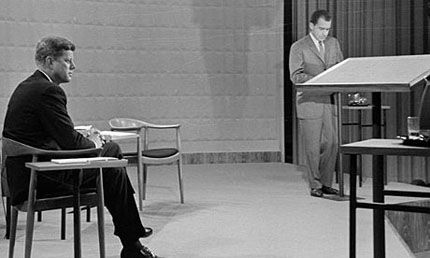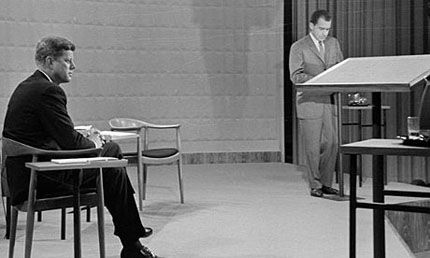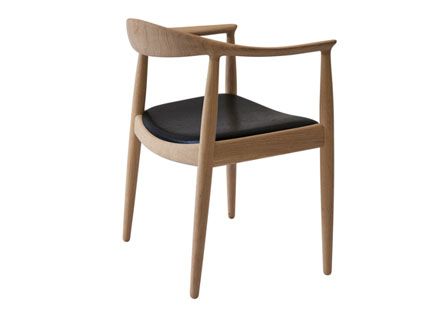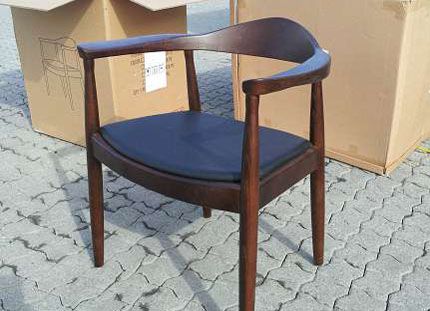
The chair was selected to adorn the set of the first presidential debate between Richard Nixon and John F. Kennedy.
Hans J. Wegner (1914 – 2007 is widely considered to be one of the foremost names in the Danish mid-century modern design movement. Over 100 of Wegner’s chair designs were put into mass production at one time or another-the chair above being just one example. It is still produced by the Danish furnishings company, PP Mobler.
Dubbed “the round one” by Wegner, this chair became an icon for the movement. So popular was “the round one” that it was selected to grace the set of the first presidential debate between Richard Nixon and John F. Kennedy. As such, it has been copied too many times to count, and as one Norwegian restauranteur recently found out, this iconic chair’s hallmark design is zealously guarded. According to DanishFurniture.dk, this past Spring, PP Mobler was contacted by Norwegian customs officials who had intercepted a shipment of 100 copies of the company’s world famous chair…The fake chairs, produced in China, were intended for a customer in Norway, who had planned to use them to furnish a restaurant.
So what happens when 100 Chinese reproduction of an iconic, and apparently trademarked chair, are intercepted by customs officials. Hold on to your hats, folks, this is going to sting:
Even though the client offered PP Mobler a substantial amount to release the chairs, this was of course refused. Instead, the entire consignment was destroyed at the customer’s expense.
Ouch! I’ve got to admit, it pained me to see the video of the shipment’s destruction posted below. That said, a designer’s efforts need to be respected. Why should any company be able to profit by producing knock-offs of someone else’s stunning design? I’m curious as to your thoughts. For example, should a woodworker be permitted to earn an income by way of reproducing the current works of other established furniture makers? Chime away in the comments section below.
Special thanks to Shop Talk Live listener, Tuck, who turned us on to this story.


























Comments
I don't have an opinion one way or the other on how to handle copies. Society is wasteful. Resources were poured into the creation of those, at least get some use out of them. Tossing everything in a landfill is just wrong to me.
How many people have created a version the Windsor chair? Is that famous design protected? How about Stickley-styled furniture? And what happens if I make a chair that is slightly different but similar to Wegner's? protectionism is an age-old practice in Europe dating back to medieval times, and I think it is ingrained in the culture. This may be a good thing for preserving fine craftsmanship but it certainly isn't helping their economy all that much. New ideas and innovation are what drive economic growth, not riding one's own coat-tails for as long as possible.
It seems to me that if PP Mobler has production rights over this trademarked design there is ample justification in
taking the appropriate measures in order to stop this chinese manufacturing company. I am well aware of how far they will go to make a profit and copyrights or trademarks are not within their priorities. As woodworkers we have all used popular designs within our work, but we know that outright cloning anything without having at least a written aproval for mass production is basically a crime. Destroying them is another thing, maybe donating these chairs to some charity or foreign entity in need would serve a less wasteful purpose and still send the message.
This is entirely appropriate. Even giving them away devalues the brand and takes jobs from the rightful owners of the designs.
All we need is for manufacturers to roll over and let the Chinese abscond with the rest of the jobs in every other country around the world, while paying slave wages and wrecking the environment.
For those that are interested take a look at the book "Factory Man: How One Furniture Maker Battled Offshoring, Stayed Local - and Helped Save an American Town" by Beth Macy.
I don't think that this policy is right.
Two things: 1. The man is dead; even if the chair design can be seen as his "property", that should be over now that he is no longer with us. 2. A design is just an idea of form, how can one own something as intangible as an idea or "design". I say if they were saying that the chair was made by Wegner himself then they should be liable, but they weren't so let them be. In all honesty are the beneficiaries of his estate that much poorer for these knockoffs? No and I would argue that the more that these knockoffs would help to keep the chair in the peoples mind and ultimately lead to a greater appreciation for the originals.
Morally this type of knockoff can be seen as questionable but legally it should be allowed. I can't believe that they destroyed them. (I hate beaurocricies, they never create, only destroy.)
As a chair maker myself I would not be too happy with someone capitalizing on my design and the intellectual property passing on to family should be respected as well. That said, there is nothing new under the sun and no design is without influence from some other source. To use Wegners design as an influence in your own creation would be fine. Look how many people have mimicked chairs of the past. Duncan Phyfe's most famouse chair was modeled after the greek klismos chair. Woodworkers learn from those around us and try to emulate their successes, be they Phyfe, Morris, Esheric, Maloof and Wegner, but to profit passing knock offs as originals deserves no credence. Some chairs such as the windsor have been replicated to such extent that they have become public domain in design and perhaps some day Wegners work might see that homage, but call it what it is; a replica or an origional.
Wow. That's harsh. It pains to see any good furniture crushed like this what's left for the symbolic chairs of Wenger.
If you copy a Van Gogh, it's fraud and you can go to jail.
If you copy a Maloof, you can call them 'inspired by' and sell them for big money. A bigger price than if it was the copiers own design in most cases.
The Maloof should be a protected thing just as much as the Van Gogh - someone's design is their property or that of their estate.
As for Federal style or the others mentioned - those are names for decades of style from many makers as opposed to the creation of a single craftsman - that is not a comparison to copying the work of well known modern furniture artisans like Wegner.
It is one thing to create an 'inspired by' piece for your own use but completely another to try and turn that into a profit.
With your help I have taught myself how to work wood. I have made a lot of pieces. Some were my own design and some came right out of your magazine. I even sold some pieces to my family.I am reaching retirement age on my day job and hope to supplement my income with my output.I work in the basement and I am a guerrilla woodworker(I sneak up on a lot of cuts). So I will never be Thos. Moser. But like most of us I want to think I have a skill worth paying for. For me the best thing about trying something from your pages is that all the details have been worked out. The most important details like proportion and style free me up from cardboard mock ups or teaching myself cad/cam. They also cannot help but influence my own designs. I have read many of your letters over the years criticizing theft of intellectual property and your measured responses . I get it but imitation is the best form of flattery. Isn't that why you publish? To keep us interested? Pablo Picasso was asked if his art was derivative. His response?"All art is derivative."
Keep in mind that this didn't happen in the US, this happened in Norway. Different country different rules. So don't get too upset it's not your problem and it never will be. I believe it may be true that certain governments in Scandinavia played a direct role in the development of the midcentury movement, hence the destruction of Chinese knock-offs at Norwegian customs. I could be wrong but those governments may actually have some stake in profiting from certain designs. Definitely fact check me.
Ideas are cheap. Execution is where the quality comes out.
@MuskokaLayne, copying a Van Gogh is only fraud and illegal if you try to sell it as an original Van Gogh. You are free to copy it and sell it as a reproduction all you want.
The design of an item of furniture, or anything else made of wood, is intellectual property and as such ought to be respected by all and protected by law from those who do not. Once a design enters the public domain, then it may be copied wihtout compunction, except in cases of fraud as with Van Gogh example noted in the posting by MuskokaLayne.
What are the implications of producing a knock off? There is the obvious factor of greed and pursuit of profit at little effort on the part of the profiteer. Then there is the implicit admission that you simlly lack the creative imagination to produce a worthy design through your own effort. I certainly hope that I never lose the integrity and self respect that would be necessary to engage in such nefarious doings.
I have a patent for an invention I made. In the USA and other countries that patent (utility) is good for 19 years. Then the rights to it are up for grabs!
If a design is copied ( a zillion times), that is a hugh compliment to say the least and if the copies keep coming for many years...you have an icon in design.
As a designer-artist-craftsman I have studied, looked at and been inspired by many fine designers and craftsman. I always try to put myself into the final piece, that is my personal pleasure. But I can understand someone coping a certain piece exactly. In the case of China, they do it a lot.
The people (consumers) have set a demand. It not only China, it's the people hiring China to copy these pieces for the western market demand, they just fill orders like any manufacturer would. And because of their society they can do it at a very low cost sometimes degrading the original through material, finish, details and craftsmanship.
People want to spend as little as possible, I guess it is human nature. But there are people that can afford the original, (I'm not one of them).
I have to admit, it would 'hurt' is someone copied my designs and made a ton of money, (and I didn't). But hey, I had the oppportunity to take my design to production and generate through advertizing the demand.
In the case of Norway I think it may have been more than business. Wegner is a national icon of their country and they were protecting they people that paid for the rights to produce Wegners design. I appluad them for that. But were they legally right within their system?
Wegners designs were inspired by the designer before him.
I think it comes down to an individuals personal beliefs I also agree with a few comments above, If you say this is an inspired piece and name the inspiration...then at least you are showing respect for the inventor-designer, that is good, and the laws allow the reproduction to take place, after the patent is over. If you try to sell it as an original, then you are a thief.
I think that there should have been (as offered) retrobution ($) given to the the people that owned the design. They should have taken it and also been given some public credit. Rather than just distroy the efforts of the people that produced, sold a bought these chairs.
But that is just my morning opinion.
FYI...if you are interested my invention (and product) is A Faux butt hinge which I named EuroButt. It's not for everyone (especially FWW followers, but it does have it's place in the design and cabinet industry.
Best of woodworking to you all, keep enjoying yourselves, cutting up perfectly good wood, then putting it back together.
Designer-Craftsman
Birdie Miller
I am a wood turner and I have designed several styles of bowls and vases. I teach through videos and I don't mind others copying me. However, what I do object to is when someone copies me and then introduces their work into the same markets where I sell my pieces and retails them for less than my wholesale prices. This is especially true if the quality of the work is close or equal to mine. All I ask of these people is to price their work accordingly. I don't mind competing with their best but it upsets me to be squeezed out of a market I created by good but inexpensive copies.
I agree with many of the comments. It was a terrible waste of resources and I suspect the government had more stake in this than admitted. The chair itself was invented thousands of years ago and one could argue that all designs after that are violating the original inventor's idea and rights. Amends were offered but Norway decided to proceed anyway. Shame on Norway, my assessment of that country has dropped considerably.
Certainly there must be a nonprofit organization that could have found good homes for these chairs.
Before we bash the Chinese too much, let's not forget where Wegner got his inspiraton for this chair. It's very much based on classic Chinese chairs from the 17th and 18th centuries. So who copied who?
In most countries there are several different categories of intellectual property. In most countries, there are:
Utility patents, life of twenty years from filing an application, https://en.wikipedia.org/wiki/Term_of_patent;
Design patents, life of twenty years from filing an application, https://en.wikipedia.org/wiki/Design_patent;
Copyright, life of the author plus seventy years (normally) https://en.wikipedia.org/wiki/List_of_countries'_copyright_lengths;
Trademark, continuous with continuing use in commerce, https://en.wikipedia.org/wiki/Trademark.
Furniture designs, in most countries, would not be protected as a trademark, but as a design (or in some cases, a utility) invention and have a limited duration of protection. To grant trademark brand identification of a furniture design is an anomaly and rather compelling arguments can be made that a product design cannot itself be or become a trademark subject to (theoretical) perpetual protection.
Apparently Norwegian law differs.
A restaurant owner sees these handsome, reasonably priced chairs in a restaurant supply catalog and thinks they will look great in his restaurant. (It's entirely possible he's never heard of Hans Wegner, and it also seems unlikely that, with malice aforethought, he sent some Chinese manufacturer pictures and said, "Make me 100 of these--I can't afford the real deal.") He orders them, and of course, pays when he places the order. So when the shipment is intercepted by customs, the patent issues surface, and the restaurant owner offers to pay, the morons at PP Mobler turn down this unwitting accomplice to trademark infringement and insist on the destruction of the chairs. By rejecting his offer, they not only lose the profit they'd have made on the chairs that cost them nothing to manufacture, but they insure that the only ones who make any money on the episode are THE CHINESE!
I am not a lawyer nor intelligent, but I would like to know the copyright laws. If I make one of these chairs and make it a 1/2" taller or splayed an extra 1/2" or the seat height angled .5 degree further back, or even a different species of wood, does this not make it completely different and not a design copy? Should the inventor of the horse drawn wagon sue the inventor of the first car? This just seems like a complete load of bullshit. But like I admit, I am ignorant of the laws and social horseshit we call morals.
I applaud their actions!!!!!! This chair is a unique and iconic design! It also happens to be legally licensed to a company who has the sole right to reproduce this piece based on the original design by the original designer. This COUNTERFEIT chair is not 'inspired by...' nor 'based in the style of...'. It is an UNAUTHORIZED copy which STEALS revenue from the people and company who were entrusted with faithfully constructing this design.
SHAME on those of you who believe there is ANY gray area in this debate!!! THIS IS FLAGRANT PLAGIARISM!!!
As someone who is strives to produce pieces of furniture which are different from what other designers have produced, this subject is very important to me. Yes, I have been influences, but I would never want to COPY what they have created.
I am not sure how this differs from going to a trendy restaurant and having a unique and special meal created by the chef and then duplicating that and serving the same thing in your own restaurant. This happens all the time.
Or the aspiring artist who goes to a museum to copy a master so he can improve his skills.
I am guessing that the chairs were not signed and that there was no attempt to pass the work off as original Wegner work. Knowing Chinese manufacturing processes, there were probably subtle (or not so subtle) differences between the Chinese imports and the originals. This should have been enough to differentiate the chairs so that they could have been imported. I think the government protected one of their own but that they over reached.
Frankly, many of you seem to think that furniture is somehow exempt from intellectual property rights. A manufacturer selling a protected design without the rights is different from a single woodworker making a copy from themselves.
What innovation do the Chinese show when they copy everything? You should be taking the Chinese manufacturer to task.
You also don't get innovation when someone pours the effort into the original product only to see it mass marketed under cost by Chinese government supported manufacturers.
Most of you should be ashamed.
Opinions are like...well, you know the rest. Here are a few of mine.
This discussion proves that the customs officials' approach had some impact on folks beyond the parties directly involved. Deterrence is a valid motive -- including efforts to combat counterfeiters.
The legit manufacturer is blameless and above criticism -- refusing to be bought off can be admirable. Regardless, its involvement was involuntary and after-the-fact. It was the victim of a counterfeiter. The imitation/flattery idea applies to FW when it publishes how-to articles for its readers. But, that argument rings hollow to a business trying to earn income from something it owns -- which really is the point.
I also agree that the restaurant-owner is probably an unwitting victim and suffered the most. But, his/her beef is with the seller. The difficulty in getting relief is on the restaurant as it chose to do business with this seller.
The seller also gets credit for the wasted resources. I don't think the customs guys deserve any heat - they destroyed contraband. I like the idea of a donation, but I'd give the legit manufacturer a say in that decision. Hopefully, the recipient wouldn't turn around and sell the chairs to the restaurant owner.
Now, here's how to fix this problem...just kidding. I offer only two-cent opinions. Solutions are much more valuable and harder to come by. Like my refusal to buy $29 "Ray-Bans," I just don't want to be a part of that type of business.
Doing trade with China where they control the labor force and currency is just bad policy. Whatever happened to "Free Enterprise"?" Did free Enterprise sell out to the Communists for extra profits for the wealthy few? No, we should not be allowing them to copy designs and import copied products into Western Countries. Yes I'm all for conserving resources but I'm also in favor of equal trade and equal worker compensation policies.
Log in or create an account to post a comment.
Sign up Log in